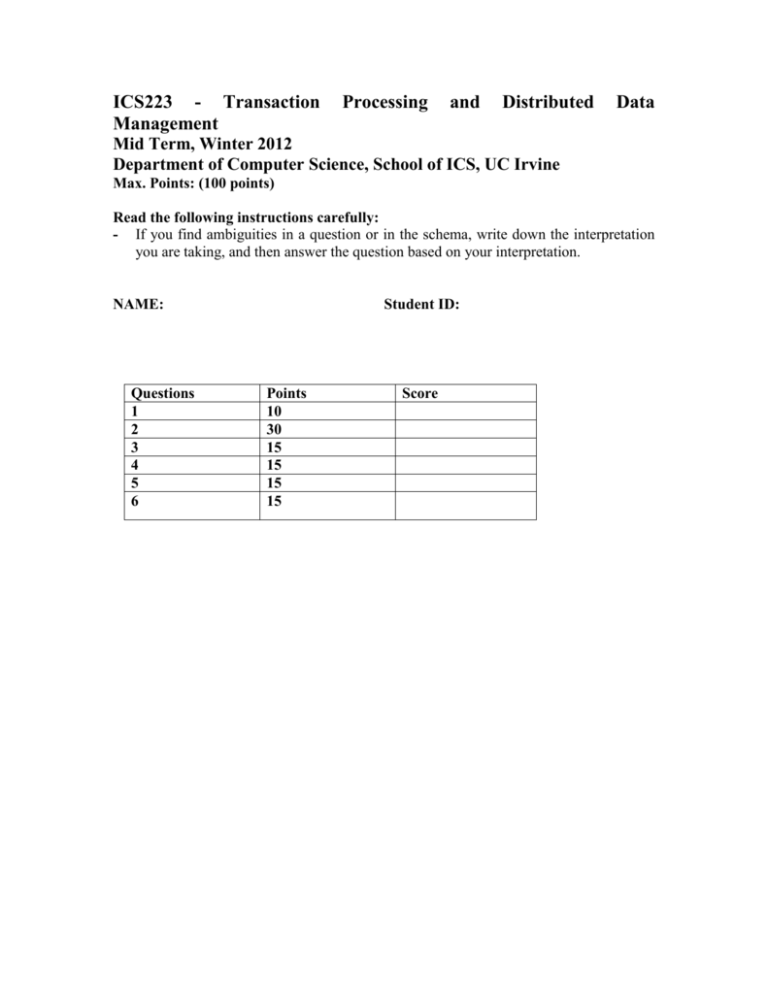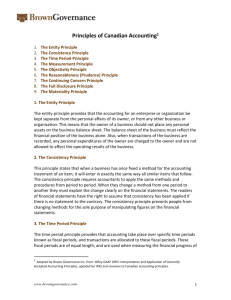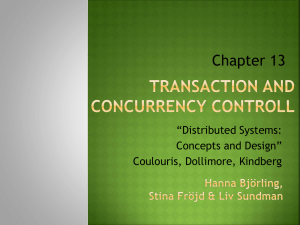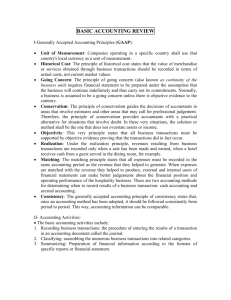mid-term-2012
advertisement

ICS223 - Transaction Management Processing and Distributed Data Mid Term, Winter 2012 Department of Computer Science, School of ICS, UC Irvine Max. Points: (100 points) Read the following instructions carefully: - If you find ambiguities in a question or in the schema, write down the interpretation you are taking, and then answer the question based on your interpretation. NAME: Questions 1 2 3 4 5 6 Student ID: Points 10 30 15 15 15 15 Score Problem 1 (10 pts) Assuming that transactions follow the correctness principle, with respect to consistency, there are several relationships between the concepts "consistent," "serial," "conflictserializable”, “view serializable” and “final state serializable”. You should determine all cases in which one of these concepts implies another. In the following diagram, if you think concept “x” implies concept “y,” then draw an arrowed edge from the node of “x” to the node of “y.” Draw all the implication edges. So that you are clear on what to do, the edge between serial and CSR is already drawn as an example. The edge denotes that every serial schedule is also CSR. You need to draw the remaining implication edges between the nodes. consistent Serial CSR FSR VSR Problem 2 (30 points) Provide very short (1-2 line if possible) explanations of the following terms/concepts/protocols. As an example, the first term (viz., no steal buffer management policy) is already explained. You need to now add similar explanations for other terms. a) No steal buffer management policy - refers to the policy wherein pages made dirty by the transaction are not allowed to be flushed to disk until the transaction commits. This policy simplifies implementation of transaction aborts since disk resident page is always transaction consistent. b) REDO logs versus UNDO logs c) Asynchronous checkpoint d) Write ahead logging e) Two phase commit protocol f) Recoverability property of schedules g) Strictness property of schedules h) Predicate serializability i) Eventual consistency j) Conservative versus aggressive schedulers k) Wound-wait strategy for priority based scheduling of transactions l) Deadlocks versus livelocks m) Hot Spots n) Throughput versus response time o) Data contention versus resource contention Problem 3: (15 points) Consider a system that uses multi version time stamp ordering for concurrency control. Let us consider that the data item X has currently the following versions <X1, X2, X3, X4> with the following read/write timestamps and values Version Value Read Timestamp Write Timestamp x1 10 20 12 x2 14 28 25 x3 12 43 40 x4 20 50 45 Explain what would happen if a transaction issues the following operation on data item x -- would the operation be executed? aborted? will a new version of x be created? If so, what will its read and write time stamp be? How will the read/write stamp of existing versions change if a new version is not created? a) T requests a read(x) operation. T’s timestamp of 13 b) T requests a read(x) operation. T’s timestamp is 22 c) T requests a write(x) operation. T’s timestamp is 41 d) T requests a write(x) operation. T’s timestamp is 44 Problem 4: (15 points) Degree two consistency: Databases often support degree two consistency wherein transactions acquire S (X) locks for reading (updating) records. While a transaction following degree-two consistency must hold onto its X locks until commit or abort, it may release its S locks at any time (in particular even before it has acquired all its locks). a) Does degree-two consistency ensure conflict serializability? If yes, provide an intuitive argument. Else, show through an example that even if transactions follow degree-two consistency, CSR may be violated. b) Does degree-two consistency ensure VSR? If yes , provide an intuitive argument. Else, show through an example that even if transactions follow degree-two consistency, VSR may be violated. c) Does degree-two consistency avoids cascading aborts? Again provide an intuitive justification, or show through an example that even if transactions follow degree-two consistency, it may result in cascading aborts. Problem 5: (15 points) Consider the following generalization of the path protocol we studied in class to tree structures. In the protocol, transactions only acquire X locks. Each transaction T can lock a data item at most once and it observes the following rules: 1. the first lock by T may be on any data item 2. Subsequently, a data item d can be locked by T only if the parent of d is currently locked by T. 3. Data item may be unlocked at any time. 4. A data item d locked and unlocked by T cannot subsequently be relocked by T. Does the above tree protocol ensure that the execution is conflict serializable. Provide an intuitive justification, or provide an example illustrating that it might result in the violation of CSR. Problem 6: (15 points) Now consider a generalization of the tree protocol to a forest protocol in which the database is organized as a forest of rooted trees. Each transaction T must observe the following rules: 1. The first lock in each tree may be on any data item 2 The second, and all subsequent locks in a tree may be requested only if the parent of the requested node is currently locked. 3. Data items may be unlocked at any time. 4. A data item cannot be relocked by T after it has been unlocked by T. Does the above mentioned forest protocol ensure that schedules are CSR. Either provide an intuitive argument as to why or show an example illustrating that it may result in violation of conflict serializability.





